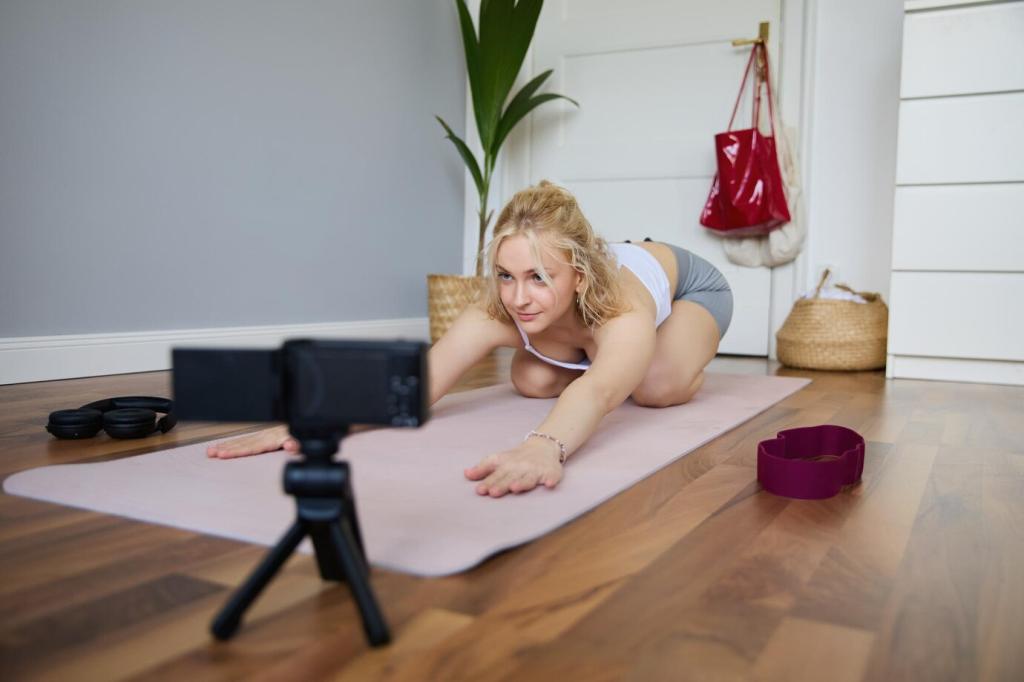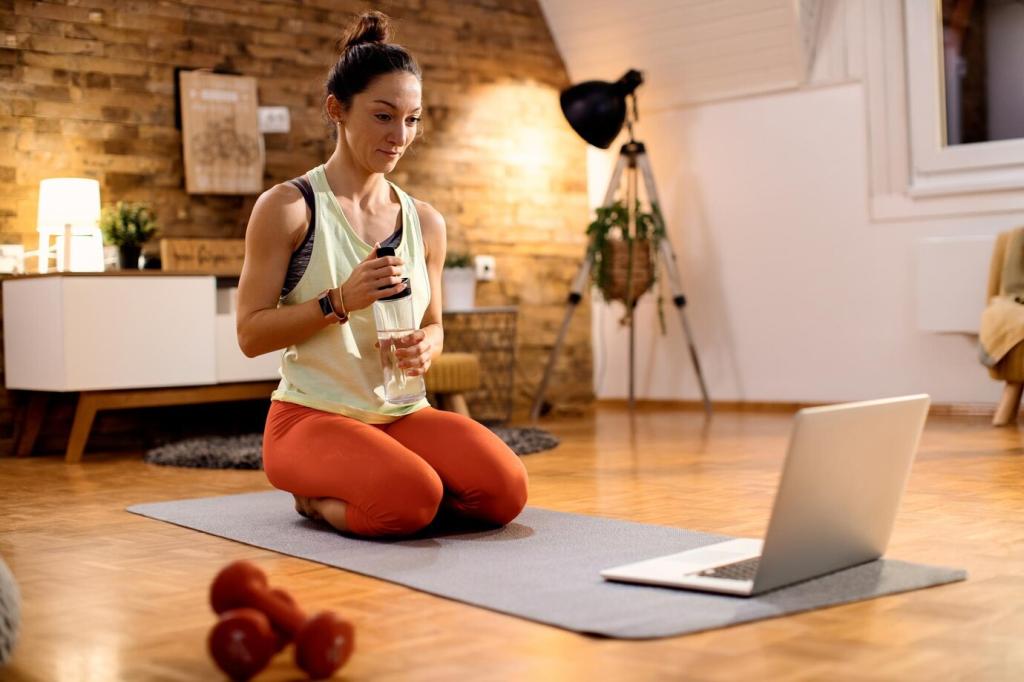Virtual Home Strength Training: Build Power Where You Live
Start with adjustable dumbbells, a sturdy mat, a looped resistance band set, and a door-frame anchor. Add fractional plates or micro-loading magnets for progressive overload when small jumps matter. A step or bench expands movements without crowding your room. Keep gear visible to encourage quick sessions, and share your minimalist setup in the comments—your solution might inspire a fellow beginner to finally start.
Set Up a Powerful Virtual Strength Space
Use a phone tripod at hip height and film at 45 degrees for squats and hinges; front and rear angles reveal knee tracking and spinal alignment. Good lighting prevents shadows that hide crucial details. Slow-motion replays help you spot early hip rise on deadlifts or elbow flare during presses. Post a quick clip link in the thread, and we will cheer your progress and help you refine cues.
Set Up a Powerful Virtual Strength Space

Squat and Hip Hinge Cues You Can See
Place a broomstick along your spine to feel three contact points—head, upper back, and sacrum—while hinging. Watch for knees tracking over the middle toes during squats and a stable midfoot balance. On video, pause at the bottom position and check hip depth, lumbar neutrality, and ribcage control. Share a still frame in the comments and describe what you notice; we will offer one actionable cue to try next session.
Pressing Mechanics Without a Spotter
Use the floor press to limit range and protect shoulders when training alone. For push-ups, imagine screwing hands into the floor to create external shoulder rotation and stable lats. Track your elbow path with chalk marks to avoid excessive flare. Tempo controls like three-second lowers replace heavy loads effectively. Reply with your best home pressing variation and the cue that finally made your reps feel smooth.
Real-Time Feedback with Mirrors and Apps
Angle a mirror slightly forward so you can glance without twisting. Training apps that count reps, analyze range of motion, or slow your video to quarter speed add precision to your virtual routine. For deadlifts, use a hip-height line on the wall to confirm consistent lockout. Tag your go-to tool in the comments, and subscribe for a monthly roundup of the most useful, budget-friendly home-tech upgrades.


Programming Progressive Overload at Home
Try four-week blocks: start with higher reps and slower tempos to build positions, then shift toward moderate reps with added load or density. Anchor each week with two main lifts and two accessory movements. Rate sets by two reps in reserve (RIR) to stay honest. Comment with your current split, and we will suggest one small tweak to help your home program progress without burning you out.
Programming Progressive Overload at Home
Manipulate tempo with three-second eccentrics, one-second pauses at the hardest point, and intentful, fast concentric phases. Shorten rest periods to increase training density or add band tension to challenge the strength curve. Try mechanical drop sets—elevated push-ups to floor push-ups to knees—to finish strong. Tell us which intensity technique made you sweat today, and subscribe for next week’s home finisher ideas.

Motivation and Mindset for Virtual Consistency
On a tough Wednesday, I promised myself ten minutes: one warm-up circuit and two strength sets. Momentum took over; thirty minutes later, I logged a clean PR. The rule removes pressure and invites action. Share your own minimum viable session for Virtual Home Strength Training, and let’s build a comment thread of realistic plans that beat perfectionism every single time.

Injury-Smart Strength at Home
Use the RAMP sequence: Raise heart rate with jump rope, Activate glutes and mid-back with bands, Mobilize hips and thoracic spine, and Potentiate with two rehearsal sets. Keep it under eight minutes and focused on your main lift. Tell us your go-to activation drill for squats or hinges, and we will share a community-built warm-up playlist tailored for home training energy.
Injury-Smart Strength at Home
Try Romanian deadlifts with a dowel spine check, suitcase deadlifts to challenge obliques, or band-resisted hip hinges to groove patterning. Stop each set one rep before breakdown. Elevate weights on books or blocks to keep range of motion safe. Comment with the hinge variation that feels best in your Virtual Home Strength Training routine, so others can experiment with it safely.
Community Energy in Virtual Sessions
Set expectations with your remote coach or training buddy: the angles you will film, the cues you want, and the metrics you will track. Keep feedback focused on one fix per lift. Share a short clip this week and ask for a single cue. Comment your top coaching question about Virtual Home Strength Training, and we will tackle it in a future community post.
Community Energy in Virtual Sessions
Simulate group momentum with a countdown timer, a shared playlist, and synchronized start times. Announce your session in a chat thread and post a sweaty selfie afterward. That little ritual makes the effort feel communal. Drop your preferred training hour and a genre for our next community playlist, and subscribe to get the link before the next virtual lift-off.
Community Energy in Virtual Sessions
Maya started with two bands and a yoga mat; ninety days later, her push-ups doubled and back pain faded. Your story could be the spark for someone’s first day. Write three sentences about your journey with Virtual Home Strength Training, tag your toughest moment, and the habit that changed everything. We cannot wait to read, applaud, and learn from you.
